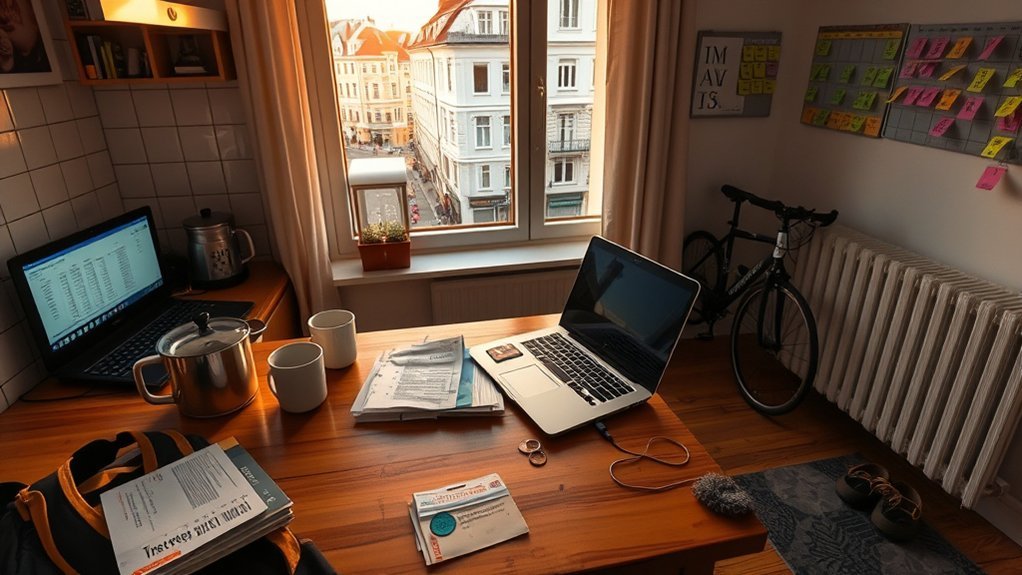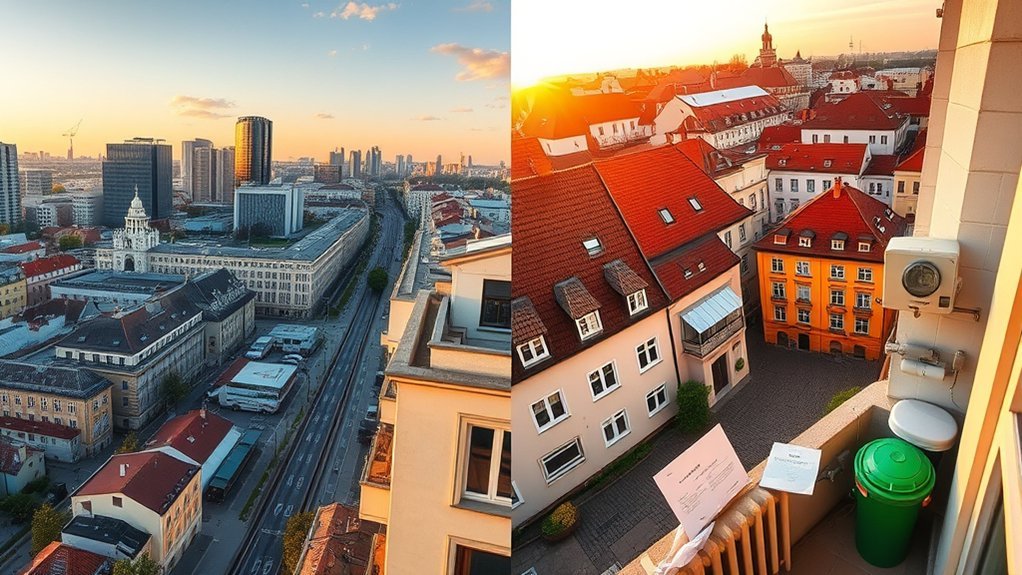You can live modestly in Poland on about €330–€600 a month as a student, but expect much higher costs in major cities. In Warsaw a one‑bedroom averages ~3,500 PLN and two‑bedrooms ~4,500 PLN; couples typically spend 9,200–11,000 PLN/month. Utilities add 700–1,200 PLN, groceries for two run 1,000–2,000 PLN, and transport passes are ~100 PLN. Wages vary — minimum is 4,666 PLN gross — and the next section breaks down specifics and savings tips.
Monthly Budget Breakdown for Students and Couples

Wondering how far your money will go in Poland? You’ll plan a monthly budget differently depending on whether you’re students or couples.
As a student, expect €330–€600 per month; major cities like Warsaw push you toward the top of that range because living expenses are higher.
For couples, typical monthly living expenses run about 9,200–11,000 PLN, which covers rent, grocery, healthcare, and essentials.
Rent is a major line item: a one-bedroom in Warsaw averages ~3,500 PLN, while a two-bedroom averages ~4,500 PLN.
Grocery costs for two generally fall between 1,000–2,000 PLN monthly, or roughly 200–350 PLN per weekly shop.
Transportation is affordable: single bus or tram rides are ~4 PLN, and monthly passes cost about 100 PLN.
Use these averages to build a precise monthly budget: sum rent, grocery, transportation, and a buffer for utilities and incidentals to avoid surprises and keep your finances on track in Poland.
Housing and Utilities: What to Expect in Different Cities

With monthly budgets in mind, housing and utilities will likely be your biggest variable — especially if you pick Warsaw, where a one-bedroom averages ~3,500 PLN and two-bedrooms about 4,500 PLN per month.
You’ll find the average rental price in Warsaw is the highest, so expats should plan accordingly. Utilities typically add 700–1,200 PLN monthly; czynsz fees can be up to 300 PLN on top of rent.
Airbnb stays in urban areas average around €1,000 per month, reflecting demand spikes.
- In smaller cities like Poznań and Katowice you can secure budget-friendly options: rooms from ~2,500 PLN and apartments near 4,000 PLN.
- If you prioritize lower rent, target non-central neighborhoods where one-bedroom apartment costs drop noticeably and utilities remain within the typical range.
- For short-term changes, compare Airbnb versus long-term leases: Airbnb gives flexibility but often at a higher monthly effective rate than standard rent.
Balance location, rent, and utilities to fit your budget.
Food, Transport and Healthcare Costs Explained

Expect grocery bills for two to fall between 1,000 and 2,000 PLN monthly (roughly 200–350 PLN per week).
Grocery costs for two typically range from 1,000–2,000 PLN monthly (about 200–350 PLN weekly).
For food you’ll find a traditional meal for two at about 130 PLN; dining higher-end (sushi) runs 200–250 PLN. Weekly and monthly food expenses hinge on shopping habits and eating out frequency.
For transport, single bus/tram rides cost ~4 PLN; a monthly transport pass is about 100 PLN, making urban commuting predictable.
If you drive, gasoline averages 6 PLN per liter; taxis start at 8–10 PLN plus 4–5 PLN/km, so factor distance into costs.
Healthcare is tiered: free public care applies if you contribute to the NFZ, reducing out-of-pocket risk.
Private insurance averages 400 PLN monthly and speeds access; specialist consultations range 150–400 PLN each.
Combine these figures to model your monthly household expenses reliably, adjusting for lifestyle, city, and occasional medical or transport surges.
Salaries, Minimum Wage and Affordability by Region

After looking at typical household outlays for food, transport and healthcare, it’s time to examine how those costs stack up against earnings across Poland.
You’ll note the minimum wage (4,666 PLN gross monthly; 30.50 PLN hourly) sets a baseline, but it’s below typical monthly living expenses for a couple (9,200–11,000 PLN). The average salary (~8,600 PLN gross) improves affordability in many regions, yet variation by industry and location matters.
- In major cities like Warsaw, rent and general cost of living reduce disposable income sharply, so average salary doesn’t stretch as far for essential purchases.
- Outside big urban centers, lower rents and living expenses mean the same monthly salary yields higher disposable income and better affordability.
The absolute minimum monthly living cost (2,500–3,000 PLN per person) highlights gaps: minimum wage covers subsistence for one only marginally, so household composition and regional rent drive real purchasing power.
Money-Saving Tips and Choosing the Right City

Why pick one city over another? You’ll lower costs by choosing smaller cities: Poznań or Katowice typically offer cheaper living than Warsaw, where monthly expenses can reach €600.
Why choose a city wisely: smaller places like Poznań or Katowice are cheaper than Warsaw, where costs can hit €600
For students, average monthly costs range €330–€430 depending on city and lifestyle, so city selection directly affects your budget. Prioritize budgeting: list fixed expenses (rent, utilities, transport) and variable ones (food, entertainment) to spot savings.
Seek economical housing — rooms from 2,500 PLN reduce rent burden compared with solo flats. Use public transportation: a monthly pass costs ~100 PLN and beats car ownership and parking fees.
Hunt student discounts and local offers for groceries, cinemas and cafes to trim variable costs. Monitor monthly spending with a simple tracker and adjust habits if entertainment or dining exceeds planned limits.
Frequently Asked Questions
Can a US Citizen Live in Poland?
Yes — you can live in Poland; you’ll apply for a visa or residence permit (work, study, family), meet requirements, and budget for living costs, healthcare contributions or private insurance, and plan around local salary and city expenses.
Is It Cheaper to Live in Poland or the US?
It’s cheaper to live in Poland; you’ll pay roughly €330–€600 monthly versus over $2,000 in major US cities. Rent, groceries, and transport are considerably lower, and Poland’s minimum monthly salary supports a decent living.
How Much Is Rent in Poland per Month?
Want specifics? You’ll pay about 3,500 PLN for a one‑bedroom in Warsaw, 4,500 PLN for two rooms, with rooms from 2,500 PLN, apartments from 4,000 PLN, plus 700–1,200 PLN utilities and up to 300 PLN czynsz.
Is Poland a Cheap Place to Live?
Yes — you’ll find Poland relatively cheap versus Western Europe: expect monthly basics around 2,500–3,000 PLN, student costs €330–€600, one-bedroom rent ~3,500 PLN in Warsaw, groceries 1,000–2,000 PLN for two.
Conclusion
You can live comfortably in Poland on a modest budget, but costs vary by city: Warsaw and Kraków run higher, smaller cities are cheaper. Expect rent + utilities to be your biggest expense, groceries and transport to be predictable, and healthcare affordable with insurance. Salaries and the minimum wage influence affordability—compare income to local prices. Save by choosing mid-sized cities, using public transport, and sharing housing; think of your budget like a map, precise and navigable.


